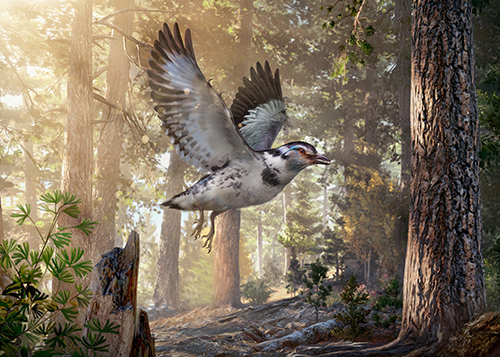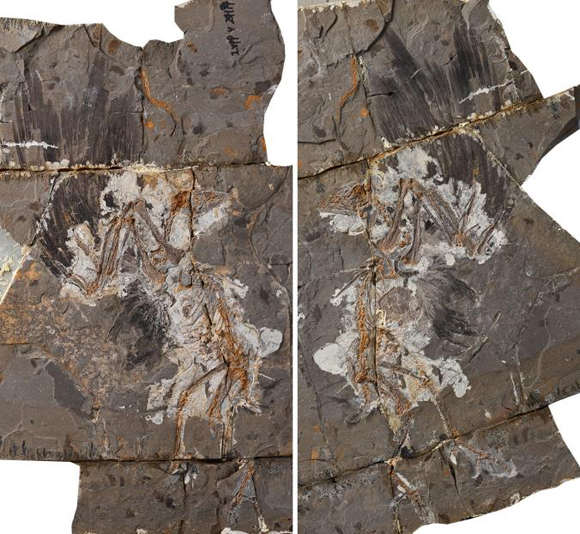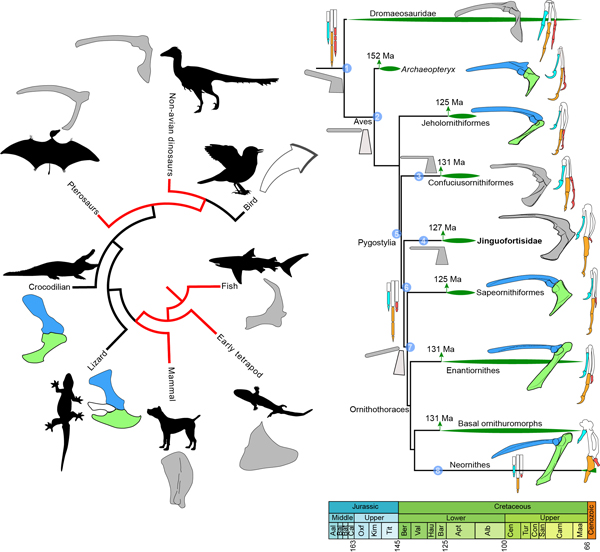New Study Suggests Bird Evolution is Very Complicated
Jinguofortis perplexus – A Mosaic of Dinosaur and Bird Features
Scientists from the Chinese Academy of Scientists have described a new species of ancient, Early Cretaceous bird with a mosaic of dinosaur and bird characteristics. The bird, which has been named Jinguofortis perplexus, lived approximately 127 million years ago and it will help palaeontologists to learn more about bird development and the evolution of powered flight in the avian dinosaurs.
Jinguofortis perplexus
An Illustration of the Newly Described Early Cretaceous Bird Jinguofortis perplexus

Picture credit: PNAS (Chung-Tat Cheung)
The pigeon-sized bird does not have a long bony tail, a characteristic inherited from dinosaurs that is found in the first birds such as Archaeopteryx. Instead, the tail is much reduced and ends with a compound bone, a pygostyle, possessed by modern birds today. Jinguofortis perplexus represents a transitional form, after birds had lost their dinosaurian tails but before they had evolved a fan of flight feathers on their shortened, compressed tails.
Honouring the Contribution of Female Scientists
The fossil specimen comes from the Debeigou Formation of north-eastern China and the genus name “Jinguofortis” derives from the Mandarin word for female warrior “jinguo” and the Latin word “fortis” meaning brave and strong. The name honours the contribution made to palaeontology by female scientists around the world. The species or trivial name “perplexus” is from the Latin and reflects the puzzling mix of anatomical traits. Jinguofortis has been assigned to a basal member of the clade of short-tailed birds (Pygostylia).
The Slab and Counter Slab of the Fossil Bird Jinguofortis perplexus

Picture credit: PNAS (Proceedings of the National Academy of Science)
Avian and Dinosaurian Characteristics
Writing in the academic journal “Proceedings of the National Academy of Sciences (USA)”, the researchers Wang Min, Thomas Stidham and Zhou Zhonghe (Chinese Academy of Sciences), describe a unique combination of anatomical traits, including a jaw with small teeth like Jinguofortis’s theropod dinosaur relatives as well as a short bony tail ending in a pygostyle. Gizzard stones associated with the well-preserved, but rather flattened fossil, indicate that Jinguofortis may have fed on seeds and other plant material. Jinguofortis also possessed a third finger with only two bones, unlike other early birds.
For dinosaur and prehistoric animal models: Prehistoric Animal Models.
Fused Shoulder Bones
Close examination of the slab and counter slab revealed that the shoulder girdle of Jinguofortis was fused into a single bone, the scapulocoracoid, a feature associated with the non-avian dinosaurs. Modern birds usually have two bones the scapula and the coracoid that provide greater flexibility in the shoulder, ideal for flapping, powered flight. The fossil’s shoulder joint also gives clues about its flight capacity. In flying (volant) birds, the shoulder, which experiences high stress during flight, is a tight joint between the two unfused bones (scapula and the coracoid). In contrast, Jinguofortis perplexus with its fused bones suggests that it flew in a different way compared to modern birds.
Changes in the Coracoid and Scapula (Shoulder Girdle) in Vertebrates

Picture credit: Wang Min (Chinese Academy of Sciences)
The picture above plots the main changes in the shoulder joint of vertebrates from fish through to tetrapods such as amphibians, reptiles and mammals. The second part of the diagram maps the evolution of the shoulder joint from the Dromaeosauridae (the raptors), through to avian dinosaurs (birds) and shows that Jinguofortis sits between the earlier Confuciusornithiformes and the later Sapeornithiformes and is basal to the Pygostylia. The diagram provides a temporal reference and also illustrates the evolution of the bird hand with its much reduced digits from dinosaurian ancestors with their grasping hands.
Measuring the Fossil Wing of Jinguofortis perplexus
Measurement of the fossil’s wing size and estimation of its body mass show that the extinct species had a wing shape and wing loading (wing area divided by body mass) similar to living birds that need a lot of manoeuvrability. Jinguofortis lived in a dense forest. Its body plan would have assisted it to dodge and weave through the branches and dense foliage as it flew.
Jinguofortis perplexus with its mosaic of bird and dinosaur characteristics suggests that the evolution of modern birds was more complex than previously thought.
The Everything Dinosaur website: Everything Dinosaur.

